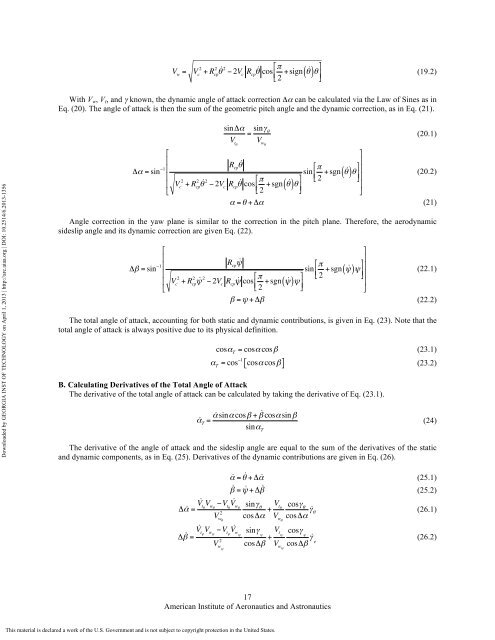Aerodynamic Stability and Performance of Next-Generation ...
Aerodynamic Stability and Performance of Next-Generation ...
Aerodynamic Stability and Performance of Next-Generation ...
Create successful ePaper yourself
Turn your PDF publications into a flip-book with our unique Google optimized e-Paper software.
V w<br />
=<br />
V 2 2<br />
c<br />
+ R <br />
cp<br />
θ 2 − 2V c<br />
R "<br />
cp<br />
θ cos π 2 + sign ( θ %<br />
)θ<br />
#<br />
$<br />
&<br />
' (19.2)<br />
With V w , V t , <strong>and</strong> γ known, the dynamic angle <strong>of</strong> attack correction Δα can be calculated via the Law <strong>of</strong> Sines as in<br />
Eq. (20). The angle <strong>of</strong> attack is then the sum <strong>of</strong> the geometric pitch angle <strong>and</strong> the dynamic correction, as in Eq. (21).<br />
Downloaded by GEORGIA INST OF TECHNOLOGY on April 1, 2013 | http://arc.aiaa.org | DOI: 10.2514/6.2013-1356<br />
#<br />
%<br />
Δα = sin −1 %<br />
%<br />
%<br />
$<br />
sin Δα<br />
= sinγ θ<br />
(20.1)<br />
V tθ<br />
V wθ<br />
&<br />
sin π (<br />
#<br />
2 + sgn ( θ &(<br />
)θ<br />
$<br />
%<br />
'<br />
(<br />
(20.2)<br />
(<br />
(<br />
'<br />
α =θ + Δα (21)<br />
R cp θ<br />
V 2 2<br />
c<br />
+ R <br />
cp<br />
θ 2 − 2V c<br />
R #<br />
cp<br />
θ cos π 2 + sgn ( θ &<br />
)θ<br />
$<br />
%<br />
'<br />
(<br />
Angle correction in the yaw plane is similar to the correction in the pitch plane. Therefore, the aerodynamic<br />
sideslip angle <strong>and</strong> its dynamic correction are given Eq. (22).<br />
#<br />
%<br />
Δβ = sin −1 %<br />
%<br />
%<br />
$<br />
&<br />
R cp<br />
ψ<br />
V 2 c<br />
+ R 2<br />
cp<br />
ψ 2 − 2V c<br />
R cp<br />
ψ cos π sin π (<br />
#<br />
#<br />
2 + sgn & 2 + sgn &<br />
ψ<br />
(<br />
( )ψ<br />
$<br />
%<br />
'<br />
(<br />
(22.1)<br />
(<br />
( ψ )ψ<br />
$<br />
%<br />
'<br />
(<br />
(<br />
'<br />
β = ψ + Δβ (22.2)<br />
The total angle <strong>of</strong> attack, accounting for both static <strong>and</strong> dynamic contributions, is given in Eq. (23). Note that the<br />
total angle <strong>of</strong> attack is always positive due to its physical definition.<br />
cosα T<br />
= cosα cosβ (23.1)<br />
α T<br />
= cos −1<br />
[ cosα cosβ] (23.2)<br />
B. Calculating Derivatives <strong>of</strong> the Total Angle <strong>of</strong> Attack<br />
The derivative <strong>of</strong> the total angle <strong>of</strong> attack can be calculated by taking the derivative <strong>of</strong> Eq. (23.1).<br />
α T<br />
= α sinα cosβ + β cosα sin β<br />
sinα T<br />
(24)<br />
The derivative <strong>of</strong> the angle <strong>of</strong> attack <strong>and</strong> the sideslip angle are equal to the sum <strong>of</strong> the derivatives <strong>of</strong> the static<br />
<strong>and</strong> dynamic components, as in Eq. (25). Derivatives <strong>of</strong> the dynamic contributions are given in Eq. (26).<br />
V<br />
Δ α = tθ<br />
V wθ<br />
−V tθ<br />
V wθ<br />
2<br />
V wθ<br />
α = θ + Δ α (25.1)<br />
β = ψ + Δ β (25.2)<br />
sinγ θ<br />
cosΔα + V t θ<br />
V wθ<br />
cosγ θ<br />
cosΔα γ θ (26.1)<br />
Δ β =<br />
V tψ<br />
V wψ<br />
−V tψ<br />
V wψ<br />
2<br />
V wψ<br />
sinγ<br />
ψ<br />
cosΔβ + V t ψ<br />
cosγ<br />
ψ<br />
V wψ<br />
cosΔβ γ ψ<br />
(26.2)<br />
17<br />
American Institute <strong>of</strong> Aeronautics <strong>and</strong> Astronautics<br />
This material is declared a work <strong>of</strong> the U.S. Government <strong>and</strong> is not subject to copyright protection in the United States.
















